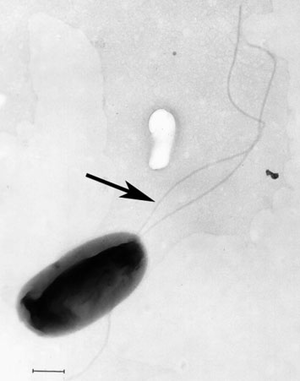Geoalkalibacter subterraneus
Classification
Bacteria; Proteobacteria; Deltaproteobacteria; Desulfuromonadales; Geobacteraceae
Species
Geoalkalibacter subterraneus
Description and Significance
Geoalkalibacter subterraneus is a gram-negative motile rod with polar flagella. G. subterraneus does not form spores. cells range in length 1.0-5.0µm, and diameter .5-.6µm. Representative strain RedT1 was isolated from Redwash oilfield Utah, USA at a depth of 1540 m at 52 °C. The salinity level was measured to be 25 g /l with pH of 7.9.
Genome Structure
Describe the size and content of the genome. How many chromosomes? Circular or linear? Other interesting features? What is known about its sequence?
Geoalkalibacter subterraneus has one circular chromosome and one plasmid, both have been completely sequenced for strain Red1T[1] The chromosome contains 3.48Mb, 3287 genes and 3202 coding genes. The plasmid contains 242Kb, 258 genes and 256 coding genes.
Cell Structure, Metabolism and Life Cycle
Interesting features of cell structure; how it gains energy; what important molecules it produces.
G. subterraneus is strictly anaerobic. It obtains energy by reducing a variety of oxidized species including Fe(III), Mn(IV), nitrate, elemental sulfur and trimethylamine N-oxide. G. subterraneus grows optimally at 40°C and pH 7.
Ecology and Pathogenesis
Habitat; symbiosis; biogeochemical significance; contributions to environment.
If relevant, how does this organism cause disease? Human, animal, plant hosts? Virulence factors, as well as patient symptoms.
References
Author
Page authored by Luke Pryke and Hannah Pak, students of Prof. Jay Lennon at Indiana University.

